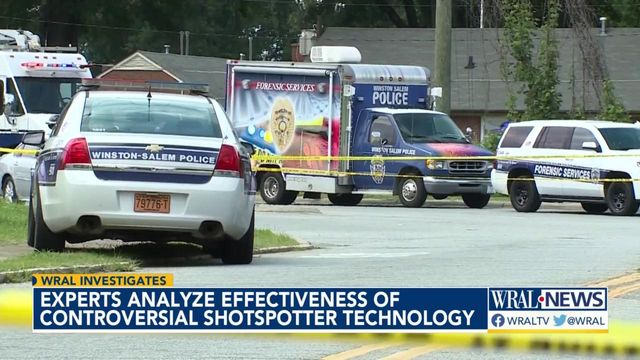WRAL Investigates whether ShotSpotter technology impacts violent crime
The ShotSpotter technology is intended to help the city identify and deploy police to an area where gunshots were heard -- even if no 911 call was placed.
Posted — UpdatedThe controversial technology called ShotSpotter is used in more than 100 cities around the country. It is intended to help the city identify and deploy police to an area where gunshots were heard — even if no 911 call was placed.
WRAL Investigates spoke with researchers who have spent years studying ShotSpotter technology, in addition to the Winston-Salem Police Department who use it every day.
In the city of Winston-Salem, residents hear gunshots hundreds of times a year. City leaders there decided to give ShotSpotter a try.
“I was a skeptic at first, I’ll admit,” said Capt. Amy Gauldin, who oversees the ShotSpotter program for the Winston Salem Police Department.
Sensors that detect shots fired and pinpoint their location is not something Gauldin could have imagined when she started as a patrol officer more than 20 years ago.
“This is new for everybody,” Gauldin said. “We were hesitate, I guess to see how it works.”
Now that Gauldin has seen it in action, the hesitation is gone.
“It allows us to get there faster, and getting there faster saves lives,” Gauldin said. “It identifies witnesses, increases the amount of witnesses we may be able to come into contact with to help solve that crime.”
Gauldin recalls an occasion where a man was shot.
No one ever called 911, but because of ShotSpotter, officers were dispatched and he survived.
“That’s worth it,” Gauldin said. “That’s what we’re here to do.”
Academic studies on the ShotSpotter technology
Dr. Anna Goldenberg-Sandau has had similar success stories.
Goldenberg-Sandau is an assistant professor of surgery at Cooper Medical School of Rowan University, and has had several articles published related to trauma surgery and acute care, in academic journals. She studies not only trauma care, but gun violence as well.
“We saw like just gunshot after gunshot,” Goldenberg-Sandau said of the patients she treats as a trauma surgeon in Camden, New Jersey.
Around 2013, she started noticing patients were arriving at the hospital more quickly than before, after being shot.
“We couldn’t figure out how they were coming in, why they were coming in so fast and that’s when I learned about the idea of ShotSpotter,” Goldenberg-Sandau said.
Yet, not all studies of the technology have been favorable.
Doucette studies gun violence in his role at Johns Hopkins University's Bloomberg School of Public Health. He received a doctorate from the school in 2018.
“We found that there wasn’t any significant reduction in violence from a statistical perspective,” Doucette said.
Doucette explained the other findings.
“We also found that, things like weapons-related arrests and homicide clearance rates were not affected by the implementation of the technology as well,” Doucette said.
However, Trident DMB Director Simone Jackenthal disputed the findings of Doucette's research, claiming the methodology is flawed. She provided WRAL Investigates with a written statement explaining the reasoning:
"The assessment of ShotSpotter's efficacy was measured using data from across entire counties, when ShotSpotter coverage areas typically only cover a small part of counties," Jackenthal wrote. "ShotSpotter does not detect and report incidents of gunfire outside of the coverage area where they are deployed.
"Therefore, the system would not alert officers to instances of gunfire in the majority of the geographic areas that were used to measure ShotSpotter’s impact."
Both Goldenberg-Sandau and Doucette agree more research on ShotSpotter is needed, and they’re doing it.
Police departments’ research of ShotSpotter
Meanwhile, police departments are doing informal day-to-day research of their own, on the job.
Gauldin said while she understands hesitations, people in Durham should keep an open mind.
“I think it’s incumbent upon each agency that implements ShotSpotter to evaluate that balance and determine the value of it for the community,” Gauldin said. “But, so far for us, it’s been beneficial.”
These are the five cities in North Carolina that have ShotSpotter right now.
Charlotte used to have ShotSpotter, but got rid of it in 2016. City staff said they are determining whether to get it again.
• Credits
Copyright 2024 by Capitol Broadcasting Company. All rights reserved. This material may not be published, broadcast, rewritten or redistributed.






